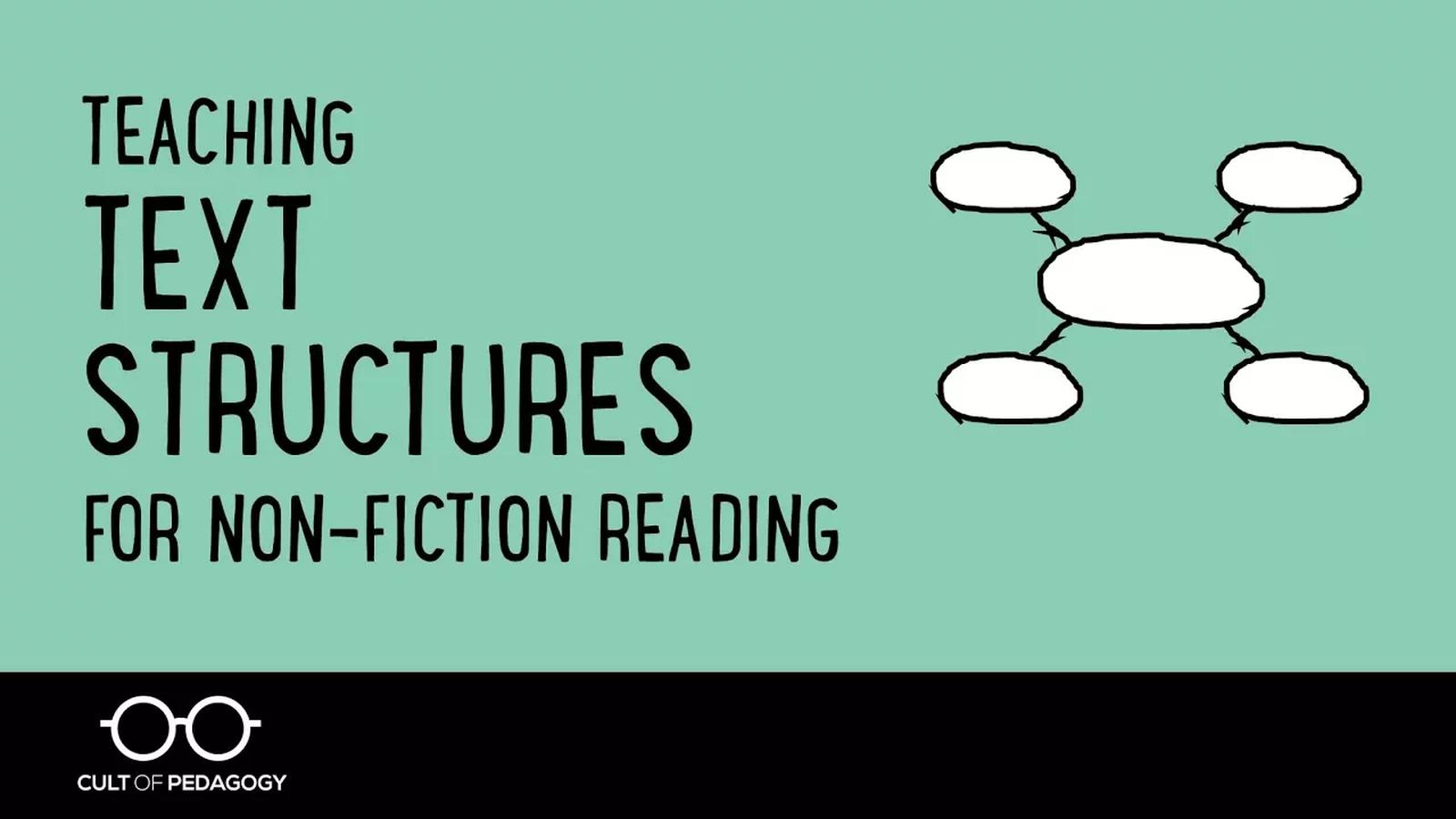All-in-One course
All-in-One course

Teaching Text Structures for Non-Fiction Reading
Learn, test, practice, and make your learning stick in one go.
1 / 8
Page 1 of 8.
Teaching Text Structures for Non-Fiction Reading
Hi, this is Jennifer Gonzalez for Cult of Pedagogy. In this video, I'm going to show you how to teach text structures to help students understand nonfiction texts more easily and remember more of what they read. First of all, what are text structures? A text structure is the way a piece of writing is organized. For example, a text that follows a description structure will introduce a topic, then describe the topic one trait at a time, developing the description of that trait with details, then moving on to another trait and following the same pattern. An article about cats, for example, might start with a description of their physical appearance, adding details about their fur, their size, and maybe even their tongue.
It might then move on to talk about their habitat, both domestic and wild, and maybe their diet, and so on and so forth. So if a student has been taught to recognize a description when she sees it, she'll get that text structure set up right away in her mind, except that it'll start out pretty much blank. With the framework in mind, she can start plugging things in as she reads. Because she knows to expect the information to be laid out in a predictable structure, with traits being introduced, then being fleshed out by details, she'll read the piece more strategically.
And research shows she'll actually remember more of it later. Here's another example. A text that follows an argument structure will begin with a claim. That claim will be followed by several reasons, each one supported with some kind of evidence. At some point in the argument, a counterclaim will probably be introduced and the author will refute it.
Finally, a concluding statement will be given. Again, if our student can be taught to recognize when she's reading a text structured like an argument, her brain will be primed to seek out the claim. Then she'll be looking for the various reasons and the evidence to support each one.
Knowing that a counterclaim is probably in there somewhere, she'll keep that spot empty and waiting until she finds it. And she'll be looking for the refutation, too. Later on, when asked to recall what was in the text, she'll recall the structure. And this will help her remember more information from the text. Basically, the more we can teach our students to recognize the framework that texts are built on, the easier it's going to be for their brains to process those texts in a strategic way.
So if you're a science, history, or social studies teacher, you're probably thinking, don't students learn about this in English class? The answer is yes, they do. But as students get older, the reading material gets much more challenging in history, science, and other technical subjects, which basically includes everything else. If students don't practice using text structures in every class, they're going to be more likely to fail.
There's no guarantee they'll transfer the skill into that content area's material. So at this point, you might be wondering how to teach text structures. First, using graphic organizers, teach each structure one at a time. You can do this by showing students a given structure, then demonstrate how you fill it out as you read a text that's built on that structure. Then have students map the structures. Give students their own passages and have them work in pairs to map out the structure themselves. After students have studied one structure, add more structures one at a time.
Experts often recommend that you start with the simpler structures, like description and sequence, and then move on to more complex ones like comparison, cause and effect, and problem solution. These are the five most common text structures, but I'm adding the argument structure as well, since so many students will use this to develop writing pieces in the later grades. As you teach each structure, also teach its signal words, words that are commonly used in that structure so that students get better at recognizing them. Charts like this one provide lists of signal words for each structure.
To help students recognize these, have them underline the words as they come up in a passage. Once students have studied structures in shorter, simpler pieces, start to build their awareness of superordinate and subordinate structures. What are these? Well, a superordinate structure is the main overall structure used to organize a text. So suppose you have a text that's set up in an argument structure. That's the superordinate structure of the piece. But suppose for the first reason, the writer gives a detailed description of something. They have actually plugged a descriptive structure right into the larger argument structure. So that would be the subordinate structure. As students progress toward longer, more complex texts, it's vital for them to be able to determine both the larger superordinate structure and the smaller subordinate structures that further develop the concepts in the text. Finally, use common terms as a whole staff. If all the teachers in your building talk about text structures every time they engage students in reading, students will learn them that much better, and they'll understand that the structures can be applied to any kind of non-fiction reading, not just the text they encounter in English class. For tools you can use to teach these lessons, including graphic organizers, the chart of signal terms, and links to further reading, go to cultofpedagogy.com slash text hyphen structures or click directly on this link. And if you've enjoyed this video and would like to be notified every time we produce a new one, click the subscribe link. Thanks for watching and have a wonderful day.
1 / 8
Page 1 of 8.